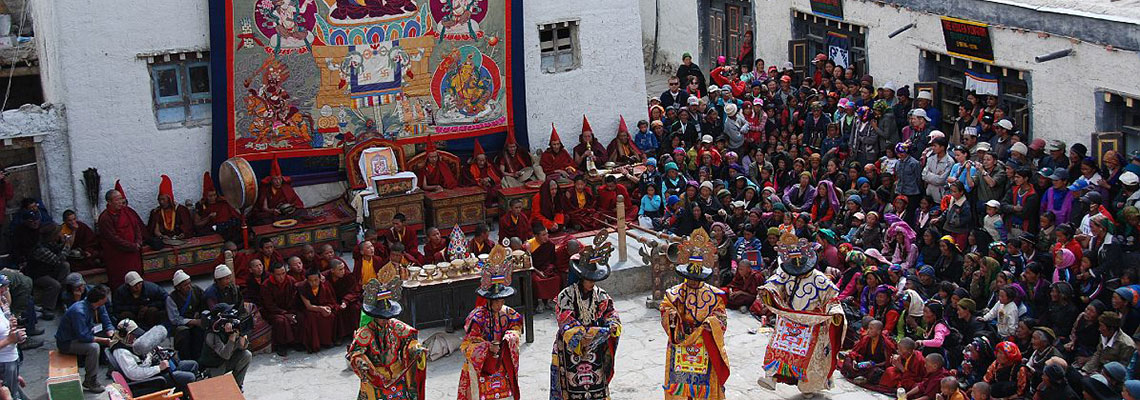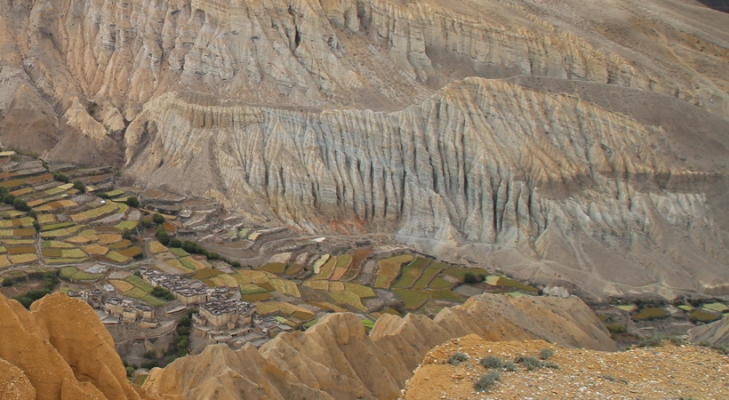Upper Mustang Trek 17 days
Upper Mustang Trek is a popular trekking destination in Nepal. The landscape of Mustang is a barren moonscape of eroded sandstone pillars and discontinuous moraine terraces, which together present a colorful mosaic made up principally of earthen reds, yellows and brown. Mustang trekking is relatively easy along the permitted route to Lo Manthang, which lies in the very heart of Mustang. The trek to Mustang leads through an almost treeless, barren landscape. Usually, strong winds howl across the area in the afternoon, subsiding at night. Being in the rain shadow of the Himalaya, Mustang gets much less rain than the rest of Nepal.
Hidden behind the majestic Himalayan ranges of Dhaulagiri and Annapurna, Upper Mustang Trek is filled with beautiful trekking zones. Mustang is one of the few places in the world with a long tradition of living in a close niche. The region has been, until recently, inaccessible to outsiders. Their isolation helped the people of Mustang to maintain their lifestyle and heritage, which has remained almost unchanged for centuries. Even today, Mustang remains one of Nepal’s most mysterious and least known kingdoms. Special trekking area permits are required by trekkers when they visit this region with a government registered trekking company of Nepal. Only camping / tented treks are allowed into the region.
| Type of Venture | Code | Duration | Group Size | Type of Treks | Elevation | Grade | Price | Best Season |
|---|---|---|---|---|---|---|---|---|
| Camping Trek | NTC-025 | 15 – 17 Days | Above 2 Persons | Lodge Trek | 5,140 m | Fairly Strenuous | Ask us | Autumn / Summer/Spring |
Group size: Flexible schedule.
NOTE: Very Exotic Trek
Day 01 Arrival at Kathmandu Tribhuvan International Airport. A representative of Sevenstar Trekking & Expeditions will meet you and transfer you to your hotel.
Day 02 Drive from Kathmandu to Pokhara (915 m), which takes about seven hours. Pokhara is a beautiful city with pleasant weather. It is well renowned as a paradise for tourists. This city is full of natural as well as cultural heritage sites such as lakes, caves, and temples of Buddhist and Hindus along with a vast array of beautiful mountains. This drive will take most of the morning, leaving much of the afternoon for a relaxing boat ride on Phewa Lake, shopping in the markets and shops or just relaxing with a drink on the shores of the lake. Stay overnight at a hotel in Pokhara.
Day 03 Fly from Pokhara to Jomsom (2,700 m), which takes about 25 minutes. Then trek from Jomsom to Kagbeni (2,810 m), taking another four hours. You take the spectacular early morning flight to Jomsom. Just out of Jomsom you cross a suspension bridge and then walk along the riverbank of the Kali Gandaki. The trail is quite barren with craggy rocks and sand and is mostly flat, which makes it very easy going. It is also very picturesque, with views of big peaks all around such as Dhaulagiri, Tukuche, and Nilgiri, whilst to the south the entire Annapurna Massif can be seen. Stay overnight in a camp.
Day 04 Trek from Kagbeni to Chuksang (2,900 m), which takes about five hours. You trek right up to the river’s valley but using a combination of the high trail and the riverbank pathways. The trail then widens significantly, revealing an endless stretch of sand. On the west bank of the river are some caves and Gompa Kang. Unlike most monasteries in Upper Mustang which are of the Sakya school, Gompa Kang is of the Nyingma school. You stop for lunch at the village of Tangbe, where you come across the first black, white and red chortens that typify Upper Mustang. The little town is a labyrinth of narrow alleys among white-washed houses, fields of buck wheat and barley and apple orchards. Nilgiri Peak continues to dominate the southern skyline. Chuksang village is only about two hours walk beyond Tangbe at the confluence of the Narshing Khola and the Kali Gandaki. Across the river from Chuksang are some spectacular red, eroded pipe organ cliffs above the mouths of inaccessible caves. Stay overnight in a camp.
Day 05 Trek from Chuksang to Samar (3,150 m), which takes about three and a half hours. There is a distinct change here, not only in the topography, but also in the culture, lifestyle, and people, and the settlements become more scattered, smaller and more basic. The people of Lo or Mustang practice agriculture. Due to scarce rain and little fertile soil, cultivation is carried out in sheltered plots of land, covering the brown landscape with patches of green vegetation. Continuing north, you reach a huge red mass of rocks that have fallen from the cliffs above – it is now forming a tunnel, and the river flows through it. The trek now leaves the valley and climbs steeply up a rocky valley to the village of Chele. From Chele, you climb a steep spur and then continue ascending to a pass, along with the side of a spectacular steep canyon. Beyond the pass, you descend on a pleasant trail to Samar, situated in a grove of poplar trees. This is a major stopping place for horse and mule caravans. Stay overnight in a camp.
Day 06 Trek from Samar to Gelling (3,510 m), taking about five hours. You climb above Samar to a ridge and then descend into a large gorge past a chorten, before entering another valley filled with juniper trees. Then cross a stream and after climbing up to a pass, you descend along a ridge to Shyangmochen, a tiny settlement with a few tea shops. Nearby is Rangbyung, a cave containing stalagmites which have formed in the shape of chortens. The trail climbs gently from Shyangmochen and you enter another huge valley before descending to Gelling with its extensive fields of barley. Stay overnight in a camp.
Day 07 Trek from Gelling to Ghami (3,490 m) via Ghami La (3,520 m), taking about five hours. From Gelling, the trail climbs gently through fields, up to the center of the valley, passing above the settlement of Tama Gun and an imposing chorten. You then begin a taxing climb across the head of the valley and up to Nyi La (3,840 m). The descent from the pass is quite gentle and about half an hour further, we come to a trail junction.The right trail is the direct route to Charing, the left trail leads to Ghami. Ghami is a large white-washed village sheltered by overhanging cliffs. Stay overnight in a camp.
Day 08 Trek from Ghami to Tsarang (3,620 m), which takes about five hours. Today’s walk is perhaps the driest part of Mustang. However, the magnificent views of the countryside, from the gentle contours of the north to the rugged mountains to the east and west, are a source of inspiration. Finally, you come to Charang, a widely spread-out village at the top of the Charang Chu canyon. At the eastern end of the village, there is a huge dzong (fortress) and a red gompa, housing an excellent collection of statues and thangkas. Stay overnight in a camp.
Day 09 Trek from Tsarang to Lo Manthang (3,730 m). This takes us about three hours. You will spend part of the morning exploring the interesting village of Charang and its large monastery, before setting out for Lo Manthang. You climb gently above the valley to a largely isolated chorten that marks the boundary between Charang and Lo. The trail then broadens and eventually you get your first view of the walled city of Lo Manthang. The city has only one entrance so you circumambulate the wall to the gate on the north-east corner. Stay overnight in a camp.
Day 10 Rest & explore Lo Manthang. Stay overnight in a camp.
Day 11 Trek from Lo Manthang to Ghami (3,490 m), which takes about six hours. You continue your journey on the highland route, crossing alpine meadows before dropping down a steeply eroded alley to Dhakmar for lunch. After lunch, you walk through the pretty valley, climb to a ridge and descend from there back to Ghami. We then stay overnight in a camp.
Day 12 Trek from Ghami to Samar, which takes about six hours. Leaving Ghami you begin to follow narrow winding paths until you reach Gelling, crossing a small stream. On the way, you can enjoy good views of the Nilgiri Mountains, deserted landscapes, Tibetan style villages, farming terraces and natural vegetation. After Geling, the path becomes broader and till Samar, we are passing deserted landscapes, natural vegetation, chortens and plateaus. Samar is a small village with terraces, Tibetan style houses, mani walls, a monastery and prayer flags, and you will find people following Tibetan lifestyle and traditions. Stay overnight in a camp.
Day 13 Trek from Samar to Kagbeni, which takes about seven hours. Following a descending path and crossing a suspension bridge over Kali Gandaki, you reach Chuksang. You then walk along the bank of Kali Gandaki with views of natural vegetation and apple orchards. Stay overnight in a camp.
Day 14 Trek from Kagbeni to Jomsom (2,713 m), taking about three hours. Your trail passes through the bank of Kali Gandaki, then through Eklebhatti. The trail is windy in the early afternoons. Jomsom is the headquarters of Mustang; you have access to the Internet and banking facilities and stay overnight in a hotel.
Day 15 Fly from Jomsom to Pokhara, which takes about 35 minutes. Flights are available in the morning, and on morning flights the sky looks very clear, granting you the chance to enjoy splendid views of different mountain peaks. Stay overnight at a hotel in Pokhara.
Day 16 Drive from Pokhara to Kathmandu by tourist bus, taking about six hours. While driving from Pokhara to Kathmandu, you head up to Damauli, Dumre, Mugling, and Kurintar, where Nepal’s first cable car is operated to reach the Manakamana Temple. En route, you can enjoy the mountain views, green sceneries, rice terrace fields, vegetable fields and people engaged in their daily chores. From Naubishe you drive up to Thankot, the gateway to the capital city of Kathmandu. You can also fly from Pokhara to Kathmandu, which takes about 25 minutes.
Day 17 Final Departure to your own destination.
Please, Email us at [email protected]
- Necessary entry/permit fee.
- Accommodation at Kathmandu standard tourist Hotel on BB Basis.
- Trekking/Climbing equipment Tents, Dining tent, Kitchen Tent, Toilet Tent and Mattresses.
- Food: Food for trekking period.
- Necessary guide staff and assistance charge.
- Insurance for all local staffs.
- Necessary domestic flight ticket.
- Necessary Land Transportation.
- Sufficient Tea & coffee during the Trekking.
- First Aid kit.
- Trekking Staff: Experience Guide and staff who have been many these area.
- Trekking food & Transport allowance for trekking assistances
- Emergency rescue evacuation if required (Seven Star team will give you full services but your insurance most cover it).
- International Air fare.
- Any kind of Alcoholic and Hard soft Drinks.
- Personal equipment for trekking.
- Insurance for travel to Nepal.
- International cargo/Air mail charge.
- Airport taxes.
- Personal accident insurance or Helicopter rescue.
- Any valuable equipment damage.
- Optional – Personal security Guard.
- Optional – Personal Medical doctor.
- Any other additional extra package charge.
- Tipping for your assistance.
Fields marked with * are required
Bookings and Payments
All Booking are made 45 days prior, with at least 20% of payment of the Trekking cost with additional full payment & other government charges. This will constitute acceptance by you of these Terms and Conditions. You need to submit a copy of each passport to our office via email or fax including two photos of passport size for TIMS Card and Trekking Permit Purpose. All payments are required per person as per trip.





